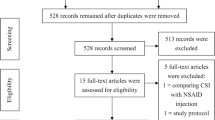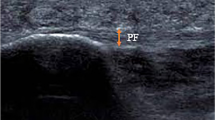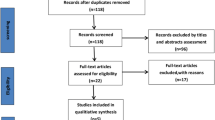Abstract
Purpose
The aim of this study was to assess the reliability of perifascial oedema as a sonographic criterion for selecting the most appropriate treatment (ultrasoundguided corticosteroid injection or ultrasound-guided extracorporeal shock wave therapy) of idiopathic plantar fasciitis (IPF).
Materials and methods
Sixty-four patients with a clinical diagnosis of unilateral refractory IPF, treated conservatively for at least 8 weeks, were studied with highresolution ultrasound (HRUS). Pain intensity was evaluated with a visual analogue scale (VAS). HRUS was used to confirm IPF and identify the presence of perifascial oedema. Patients with an HRUS diagnosis of IPF were grouped according to the presence (A) or absence (B) of perifascial oedema and then randomly allocated to treatment with corticosteroid injection (1) or extracorporeal shock wave therapy (2). Clinical and HRUS follow-up was performed 6 weeks after treatment.
Results
HRUS confirmed IPF in 68,97% of patients and identified perifascial oedema in 53.33%. Clinical and sonographic improvements were observed in 87.5% and 37.5% of patients in subgroups A1 and A2, respectively, and in 35.71% and 92.85% of those in subgroups B1 and B2, respectively.
Conclusions
The presence of perifascial oedema may represent an effective criterion for guiding treatment decisions towards HRUS-guided corticosteroid injection.
Riassunto
Obiettivo
Valutare l’affidabilità del criterio ecografico nell’individuazione dell’edema perifasciale nella scelta della terapia mini-invasiva (iniezione di corticosteroidi o onde d’urto, ESWT) con guida dell’ecografia ad alta risoluzione (HRUS) nel trattamento della fascite plantare idiopatica (FPI).
Materiali e metodi
Sessantaquattro pazienti con diagnosi clinica di FPI monolaterale, recalcitrante, trattata conservativamente per almeno 8 settimane, sono stati sottoposti ad HRUS. Il dolore è stato quantizzato con una visual analogue scale (VAS). La FPI è stata verificata all’HRUS ed è stata valutata la presenza di edema perifasciale. I pazienti con diagnosi HRUS di FPI sono stati suddivisi in (A) presenza e (B) assenza di edema perifasciale e poi suddivisi random in trattati con (1) infiltrazione di corticosteroidi e (2) ESWT. Le rivalutazioni clinica e HRUS sono state eseguite a 6 settimane.
Risultati
Nel 68,97% dei pazienti l’HRUS ha evidenziato una FPI con edema perifasciale nel 53,33%. Nei pazienti dei sottogruppi A1 e A2 è stato evidenziato un miglioramento clinico-strumentale nel 87,5% e nel 37,5% dei casi, mentre nei pazienti dei sottogruppi B1 e B2 questo è stato evidenziato nel 35,71% e nel 92,85% dei casi.
Conclusioni
La presenza dell’edema perifasciale potrebbe essere un efficace criterio nell’indirizzare la terapia verso le iniezioni di corticosteroidi con guida HRUS.
Similar content being viewed by others
References/Bibliografia
Odzemir H, Yilmaz E, Murat A et al (2005) Sonography evaluation of plantar fasciitis and relation to body mass index. Eur J Rad 54:443–447
Kane D, Greaneay T, Shanahan M et al (2001) The role of ultrasonography in the diagnosis and management of idiopathic plantar fasciitis. Rheumathology 40:1002–1008
Furey J (1975) Plantar fasciitis. J Bone Joint Surg Am 57:672–673
Gill LH, Kiebzak GM (1996) Outcome of non surgical treatment for plantar fasciitis. Foot Ankle Int 17:527–532
Sabir N, Demirlenk S, Yagci B et al (2005) Clinical utility of sonography in diagnosis of plantar fasciitis. J Ultrasound Med 24:1041–1048
Hyer CF, VanCourt R, Block A (2005) Evaluation of ultrasound-guided extracorporeal shock wave therapy (ESWT) in the treatment of chronic plantar fasciitis. J Foot Ankle Surg 44:137–143
Buchbinder R, Ptasznik R, Gordon J et al (2002) Ultrasound-guided extracorporeal shock wave therapy for plantar fasciitis. JAMA 288:1364–1372
Tsai C-W, Wang C-L, Tang F-T et al (2000) Treatment of proximal plantar fasciitis with ultrasound-guided steroid injection. Arch Phys Med Rehabil 81:1416–1421
Hammer DS, Adam F, Kreutz A et al (2005) Ultrasonographic evaluation at 6-month follow-up of plantar fasciitis after extracorporeal shock wave therapy. Arch Orthop Trauma Surg 125:6–9
Cardinal E, Chhem RK, Beauregard CG et al (1996) Plantar fasciitis: sonographic evaluation. Radiology 201:257–259
Tsai C-W, Chiung M-F, Wang C-L et al (2000) Ultrasound evaluation in plantar fasciitis. Scand J Rheumatol 29:255–259
Gibbon WW, Long G (1999) Ultrasound of the plantar aponeurosis (fascia). Skeletal Radiol 28:21–26
Akfirat M, Sen C, Gunes T (2003) Ultrasonographic appearance of the plantar fasciitis. J Clin Imaging 27:353–357
Snider MP, Clancy WG, McBeth AA (1983) Plantar fascia release for chronic plantar fasciitis in runners. Am J Sports Med 11:215–219
Genc H, Saracoglu M, Nacir B et al (2005) Long-term ultrasonographic follow-up of plantar fasciitis patients treated with steroid injection. J Bone Spine 72:61–65
Thiel M (2001) Application of shock waves in medicine. Clin Orthop 387:18–21
Wong SM, Griffith JF, Tang A, Hui ACF (2002) The role of ultrasonography in the diagnosis and management of idiopathic plantar fasciitis. Rheumatology 41:835–836
Author information
Authors and Affiliations
Corresponding author
Rights and permissions
About this article
Cite this article
Sorrentino, F., Iovane, A., Vetro, A. et al. Role of high-resolution ultrasound in guiding treatment of idiopathic plantar fasciitis with minimally invasive techniques. radiol med 113, 486–495 (2008). https://doi.org/10.1007/s11547-008-0277-2
Received:
Accepted:
Published:
Issue Date:
DOI: https://doi.org/10.1007/s11547-008-0277-2




